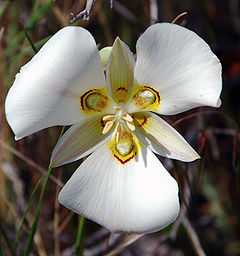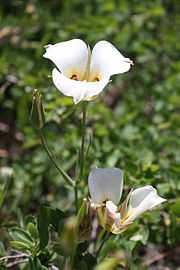Calochortus nuttallii
| Sego Lily | |
|---|---|
 | |
| Scientific classification | |
| Kingdom: | Plantae |
| (unranked): | Angiosperms |
| (unranked): | Monocots |
| Order: | Liliales |
| Family: | Liliaceae |
| Genus: | Calochortus |
| Species: | C. nuttallii |
| Binomial name | |
| Calochortus nuttallii Torr. & A.Gray | |
.jpg)

The Sego Lily, Calochortus nuttallii, is a bulbous perennial which is endemic to the Western United States. It is the state flower of Utah.
Description
The Sego Lily has 1 to 4 flowers, each with 3 white petals (and 3 sepals) which are tinged with lilac (occasionally magenta) and have a purplish band radiating from the yellow base. These appear in early summer. Plants are around 15–45 cm (6–18 inches) in height and have linear leaves.[1]
Uses
The bulbs of this and other Calochortus species were roasted, boiled or made into a porridge by Native Americans and were also used as a food source by the Mormon pioneers in Utah.[2][3] Currently, it is grown as an ornamental for its attractive tulip-shaped flowers.
State flower
The flower was chosen as the state flower of Utah due to its importance in pioneering times and its "natural beauty". It was formally adopted on March 18, 1911.[4]
Distribution
The plant is native to a number of western states including Idaho, Montana, Wyoming, North Dakota, South Dakota, Nebraska, Nevada, Utah, Colorado, Arizona, and New Mexico.[1]
Taxonomy
The Sego Lily is a species within the genus Calochortus, in a sub-group generally referred to as Mariposa Lilies. The specific epithet nuttallii, named for the English botanist and zoologist, Thomas Nuttall, was ascribed to the species by the American botanists John Torrey and Asa Gray when it was officially described in 1857.
A number of former varieties of Calochortus nuttallii are currently treated as species in their own right as follows:
- var. aureus (S.Watson) Ownbey is currently Calochortus aureus S.Watson
- var. australis Munz is currently Calochortus invenustus Greene
- var. bruneaunis (A.Nelson & J.F.Macbr.) Ownbey is currently Calochortus bruneaunsis A.Nelson & J.F.Macbr.
- var. leichtlinii (Hook.f.) Smiley is currently Calochortus leichtlinii Hook.f.
- var. panamintensis Ownbey is currently Calochortus panamintensis (Ownbey) Reveal
- var. subalpinus M.E.Jones is currently Calochortus leichtlinii Hook.f [5]
Cultivation
Sego lilies prefer a deep, sandy soil with good drainage and are cold-hardy. Plants can be propagated from newly formed bulblets which take two years to flower.[6]
References
| Wikisource has original text related to this article: |
- ↑ 1.0 1.1 "Calochortus nuttallii". Flora of North America. eFloras.org. Retrieved 2007-11-12.
- ↑ "Mariposa Lily (Calochortus nuttallii)". Native Wildflowers of the North Dakota Grasslands. Northern Prairie Wildlife Research Center. Retrieved 2007-11-12.
- ↑ Chamberlin, R.V. "The Ethno-botany of the Gosiute Indians of Utah". Memoirs of the American Anthropological Association Vol II, part 5. Retrieved 2007-11-12.
- ↑ "Utah State Flower". Netstate.com. Retrieved 2007-11-12.
- ↑ "Calochortus nuttallii". electronic Plant Information Centre (ePIC). Royal Botanic Gardens, Kew. Retrieved 2007-11-12.
- ↑ "Calachotus nuttalli". Plants for a Future. Retrieved 2007-11-12.
| Wikimedia Commons has media related to Calochortus nuttallii. |
| Wikispecies has information related to: Calochortus nuttallii |